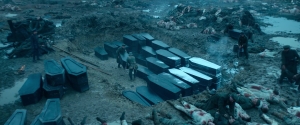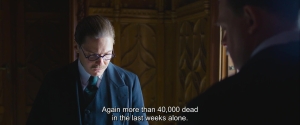Erich Marie Remarque was a German soldier who wrote about his experiences in the First World War. His books were so influential that the Nazis banned them when they gained power in 1933. The book Im Westen nichts Neues (All Quiet on the western Front) became an all-time classic. It is still regarded as one of the finest books on war and its consequences. There were two versions – the OScar winning 1930 version. The 1978 TV version. Now we have the 2022 NetFlix
To immediately jump to the conclusion that it is anti-war is naturally apparent. We all know – War Sucks. Bigtime. Yet humanity and human beings indulge in it. From rocks to atom bombs has been one giant evolutionary step in how technology has helped to kill the enemy efficiently. Yes – it’s always The Enemy. Never your side.
World War One was considered to be one of the first industrial wars. Modern technology went out of the way to help humans kill each other. The bolt action rifle soon gave way to the machine guns, which gave way to the artillery bombardments and poison gas. And on it went. It was as if the industry of one country was trying to match the industry of its enemy. Naturally, the humans behind it were merely cogs in the wheel.

All Quiet on the Western Front, the book, points out these effects of war. The mud. The death. The cowering in bunkers. Bodies being blown to bits. The camaraderie. The sheer useless nature of repeated attacks on an objective without gaining ground. The clueless civilians exhort them but prefer being safe from the front lines.
The main character is Paul Baumer. Naïve and motivated by patriotism, he joined up in 1914. But after three years of war, he has become a veteran. His friends ‘Kat” (short for Katczinsky), Tjaden, and Kropp have become cynical over the three years they have been at war and survived the mud and slaughter of the western Front against the French.

Peace negotiations, however, ensure that the starving soldiers are sent for one final assault by glory seeking General. The assault flounders, and most soldiers, including Paul, die. Each soldier’s “dog tags” is collected by one of the survivors.

That is the new version that reeks of political correctness – the soldiers are friendly. It is people above the line who send them to war. The machinations and the politics that led the Germans into the war are skipped. The early scene in the high school, where the teacher urges everyone to do their duty for the fatherland, is the only one that shows “authorities” at work.
The eager cadets who volunteered with a smile in 1914 now have forgotten to smile in 1918 – perhaps this is the only aspect that seems real.

A comparison with the 1930 black-and-white version is inevitable. That Oscar winner just told the story and didn’t make any political statements. Shot only 12 years after the end of The War, the 1930 version stayed true to the book. It showed the overall futility of the flower of a nation dying uselessly.
The 1977 colour version was slightly better in that it stayed true to the book but went for the colourful spectacular, thus drawing attention away from the story.
This version on Netflix has 104 years to get it right, and it fails. After four years of war, every starving man is looking out for himself. There is no camaraderie; it is almost like every man for himself-which may not be far from the truth.
There are some digressions where the soldiers steal food from a local farmer and are chased and shot. Kat’s end is due to the repeat of the same act at the same farm. There is a severe ‘are you kidding me” moment when this happens – this is also a deviation from the original.
The narrative severely drags when the plot goes to the rear, away from the Front, with the ongoing cease-fire negotiations. It is supposed to humanize the Germans but hardly does so. That way, the earlier two versions showed the soldiers and their suffering.

The special effects are up to par, including a combined tank-infantry attack by French St Chamond tanks which are as cumbersome as they come. Their operational disadvantages are shown in the attack.

One more real thing is that German food supplies were always a problem while the Allies had abundant food stocks. This is evident when Baumer and his team stumble into a bunker filled with lots of food but are forced to flee due to the tank attack.
The film could have been tremendous, but it settles for political correctness over showing the story as it happened.
Real History : 4 out of 5
Equipment/ Kit : 5 out of 5
Locations / Substitutes : 3 out of 5
Story/masala elements : 2 out of 5
Music : 3 out of 5
Overall rating : 3.4 out of 5
Leave a Reply
Want to join the discussion?Feel free to contribute!